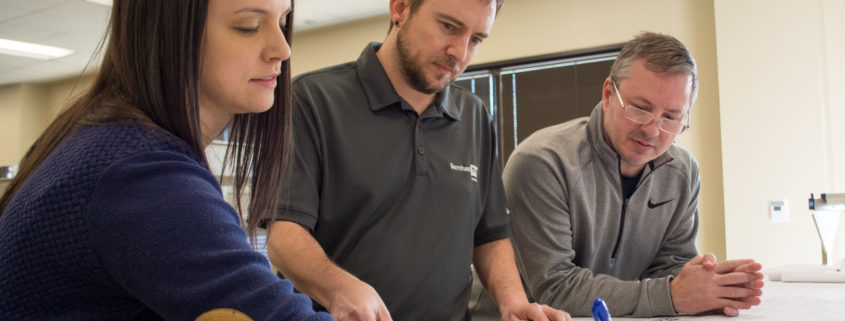Bernhard’s Engineering Division Highlights Resilience and Adaptability
By Tony Robeson, Vice President – Engineering, Bernhard
________________
This year, a fateful one, our engineering division turns 25. In a quarter century, our design and energy engineers have helped public and nonprofit institutions such as hospitals and higher education campuses and facilities expect more from their energy systems, new construction projects and existing buildings.
We’ve scaled with our clients throughout the years, from providing traditional design services for nine-figure greenfield builds to managing monthly utilities and everything in between. We’ve helped Owners set aggressive energy savings goals, then cheered as they achieved year-over-year energy savings across entire campuses.
Since its beginning, Bernhard’s engineers have also served clients in an “on-call” capacity. A common procurement method for public institutions, these contracts are convenient for completing projects that fall below a specified dollar amount (for instance, $1 million). A team of on-call consultants stand ready for small-scale renovations on a hospital or university campus, equipment upgrades, or critical emergency-responses.
These contracts relieve administrations of some of the more tedious procurement processes for ongoing needs. Through on-call contracts we have developed long-term and strategic partnerships with our clients, helping to solve problems as their ‘boots on the ground’ and serving as an extension of their own staff, helping to plan for the future.
Owner Advocacy and New Solutions
One of Bernhard’s bedrock principles is what we call “Owner Advocacy” — advancing in design and construction the Owner’s mission, vision, and goals. An on-call relationship helps us to see that vision and adopt that mission more fully.
The problems we are helping solve today are complex and unprecedented. As many of our clients are healthcare institutions, we have mobilized our staff to create a ‘think tank’ for helping to prevent the spread of COVID-19 — this includes analyzing indoor air flow, ventilation and exchange rates, filtration and exhaust, even medical gas volume (oxygen) for lifesaving equipment such as ventilators. We fully immerse ourselves in the Owner’s day-to-day needs and goals so that we can provide meaningful counsel when adaptation is required.
The Parkland Project
At Parkland Memorial Hospital in Dallas, our engineers did this for a roughly 55-bed Tactical Care Unit designed specifically for highly contagious COVID-19 sufferers.[1] We consulted with clinicians and scientists, frontline health care workers, as well as custodial and sanitation staff. Knowing that the air itself can be a vector for this virus, we worked to ensure patients in a negative-pressure isolation space had air optimized for exchange and temperature; that the opening of a door across the unit could not result in a backdraft or other interruption in airflow. We worked with staff to design spaces for the proper donning and doffing of PPE. The exhaust air pulled out of the treatment space passes through a high-tolerance HEPA filtration system to scrub contaminants so they are not able to migrate out of the patient care space.
Our goal is to be a trusted partner. That trust was established with Parkland through a large energy retro-commissioning program that saves roughly $800,000 each year. This project afforded Bernhard and the hospital familiarity, and that made our service early in their COVID-19 response fast and expert. In the end, Parkland will return to normal operations, with a census hovering north of 100% occupancy. That patient population still exists, and the moment the hospital is able to scale back on its COVID-19 response, it will have to decontaminate, readjust and return to spaces optimized for different treatment priorities. Our team will be at the ready.
Success Stories
Parkland is just one example. At Memorial Hermann in Houston we retrofitted specific rooms in its trauma centers and ER for negative-pressure isolation environments as well. In Tucson, our office made short work of complex new HVAC tubes and filtration.
At the University of Alabama at Birmingham, Bernhard provided engineering and infection control expertise, including conversion of med-surge and ICU spaces to negative pressure rooms. At another academic medical center, we provided the engineering services to transition an entire patient tower floor into 100% outside air, negative pressure rooms and ward to prepare for the sick.
These successes are a testament to our long-term relationships and our guiding principle of Owner Advocacy.
To learn more about Bernhard’s engineering services, visit Bernhard.com/engineering.
________________
Tony Robeson, PE, HFDP, CxA, NEBB BSC CP
Tony is a Vice President of Bernhard’s engineering division, where he leads design and commissioning teams in our Little Rock office. He has 30 years of experience in MEP design, and has been with Bernhard for more than 20 years. Tony specializes in delivering innovative engineering solutions for healthcare , higher education, and campus energy systems.
________________
[1] “In less than five days, the third floor of Parkland hospital was converted into a … Tactical Care Unit. The large negative pressure room maintains air flow preventing cross contamination The unit is set up kind of like a car wash — one way in and one way out — with an experienced surgical team helping staffers put on and take off their protective gear.” — KERA news




